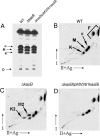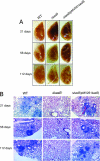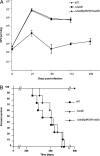Deletion of kasB in Mycobacterium tuberculosis causes loss of acid-fastness and subclinical latent tuberculosis in immunocompetent mice
- PMID: 17360388
- PMCID: PMC1829279
- DOI: 10.1073/pnas.0608654104
Deletion of kasB in Mycobacterium tuberculosis causes loss of acid-fastness and subclinical latent tuberculosis in immunocompetent mice
Abstract
Mycobacterium tuberculosis, the causative agent of tuberculosis, has two distinguishing characteristics: its ability to stain acid-fast and its ability to cause long-term latent infections in humans. Although this distinctive staining characteristic has often been attributed to its lipid-rich cell wall, the specific dye-retaining components were not known. Here we report that targeted deletion of kasB, one of two M. tuberculosis genes encoding distinct beta-ketoacyl- acyl carrier protein synthases involved in mycolic acid synthesis, results in loss of acid-fast staining. Biochemical and structural analyses revealed that the DeltakasB mutant strain synthesized mycolates with shorter chain lengths. An additional and unexpected outcome of kasB deletion was the loss of ketomycolic acid trans-cyclopropanation and a drastic reduction in methoxymycolic acid trans-cyclopropanation, activities usually associated with the trans-cyclopropane synthase CmaA2. Although deletion of kasB also markedly altered the colony morphology and abolished classic serpentine growth (cording), the most profound effect of kasB deletion was the ability of the mutant strain to persist in infected immunocompetent mice for up to 600 days without causing disease or mortality. This long-term persistence of DeltakasB represents a model for studying latent M. tuberculosis infections and suggests that this attenuated strain may represent a valuable vaccine candidate against tuberculosis.
Conflict of interest statement
The authors declare no conflict of interest.
Figures






References
Publication types
MeSH terms
Substances
Grants and funding
LinkOut - more resources
Full Text Sources
Medical
Molecular Biology Databases

